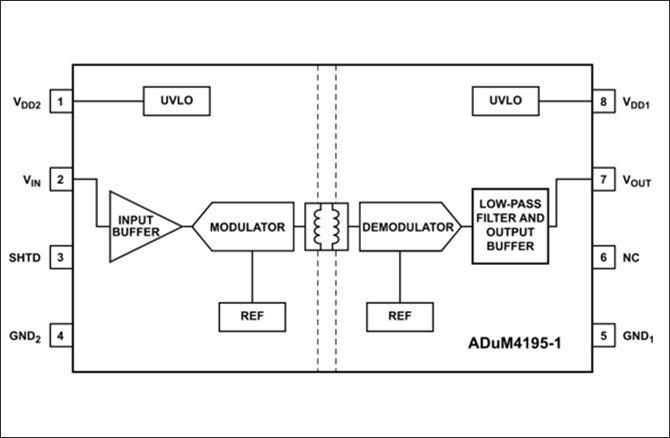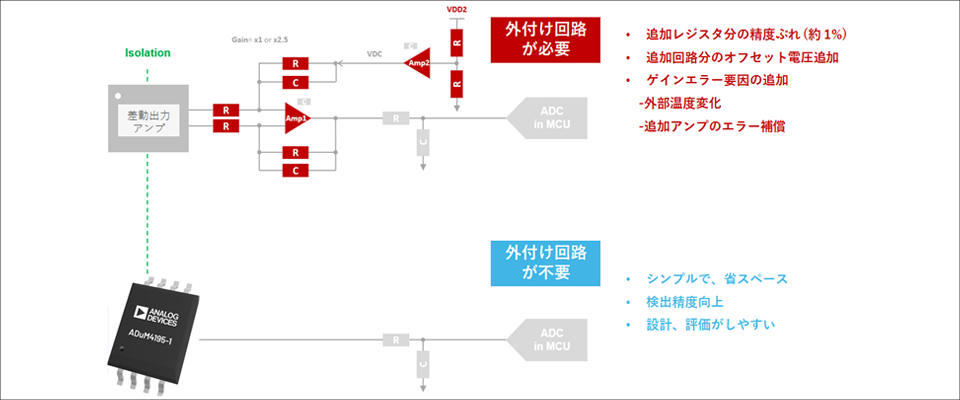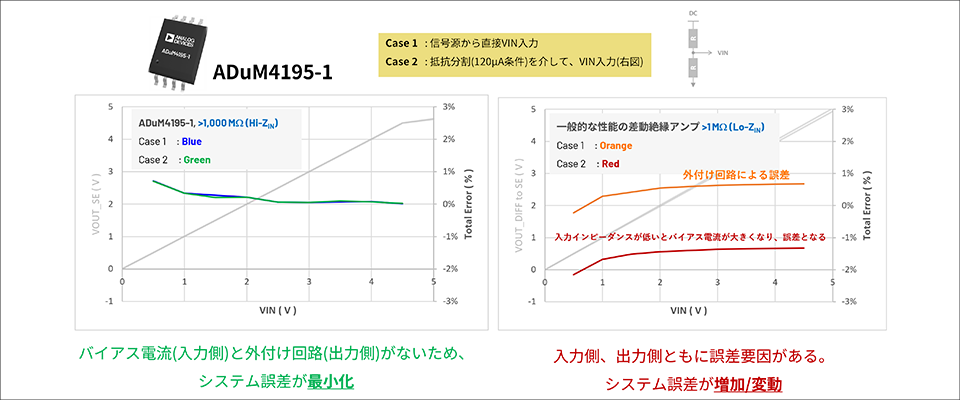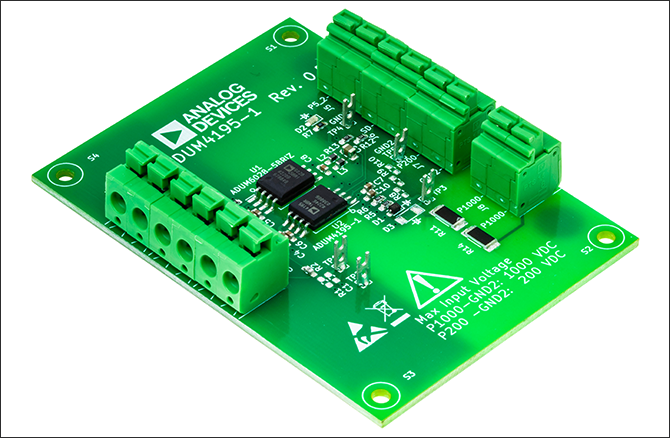People who are planning to design a voltage detection circuit are probably looking for information such as, "Which isolation amplifier is best for high-voltage isolation measurements?" or "Which has the advantages, differential output or single-ended output?"
This time, we will introduce the features of the ADuM4195-1, an isolated amplifier optimized for voltage detection, and why it is suitable for voltage detection.

What performance is required for an isolation amplifier for voltage detection?
Isolation amplifiers for voltage detection are used to improve the accuracy of high voltage measurements. What characteristics should an isolation amplifier have to achieve this goal? Let's look at the main applications of isolation amplifiers for voltage detection and the requirements that each application places on the isolation amplifier.
■Applications and requirements of isolation amplifiers for voltage detection
●Insulation measurements in industrial equipment (power conversion devices, signal conditioners, etc.)
- Capable of performing highly accurate measurements even in harsh temperature environments
・Improved reliability through reduced parts
- Robust and able to withstand long-term use
●Insulation measurements in renewable energy infrastructure (inverters, etc.)
・Safety must be ensured even in high voltage environments
Insulation measurements in EVs (powertrains, charging devices, battery management systems, etc.)
・The circuit can be miniaturized to fit the limited mounting space.
- Accurate measurements even in harsh noise environments can extend the driving range
The ADuM4195-1 isolation amplifier from Analog Devices is an ideal product to meet these requirements.
What is the isolation amplifier "ADuM4195-1"?
What are the features of the ADuM4195-1? The ADuM4195-1 is a fixed gain, single-ended output isolated amplifier. Its main features are as follows, which contribute to the realization of high-precision voltage detection circuits.

■Compact package with high insulation performance
・Increased creepage distance 8-pin Wide body SOIC
■High-precision output
Output voltage range: 0.25V to 4.3V (typ.)
・Output offset voltage: ±5mV (max.)
・Output gain error: ±0.5% (max.)
■Low power consumption
・4.9mA (max.) primary
・7.3mA (max.) secondary
In particular, the three characteristics that make the ADuM4195-1 ideal for high voltage measurement are "single-ended output", "wide input/output voltage range (0.25V to 4.3V)", and "high input impedance (1GΩ (typ.))". These characteristics enable a reduction in the number of components, space saving, and improved accuracy and reliability. Let's take a closer look.
Benefit from single-ended output and wide input/output voltage range
First, what advantages does a single-ended output bring to a voltage detection circuit? Let's consider the circuit configurations when using a typical differential output isolated amplifier and when using the ADuM4195-1. The diagram below shows an image comparing the two.

Normally, in a voltage detection circuit, the signal from the isolation amplifier is sent to an AD converter built into a microcontroller. In the case of an isolation amplifier with a differential output, the differential signal output from the two terminals must be converted to a single-ended signal before being input to the AD converter. In addition, the input/output voltage range of most conventional isolation amplifiers is around 2V, so amplification and level shifting are required to adjust the voltage range to suit the AD converter.
These signal adjustments require external circuits such as multiple operational amplifiers, which increases the number of components and increases various error factors. For example, the offset voltage and gain error of the operational amplifier, and the temperature characteristics of the resistor components are factors that cause errors. Not only does the circuit area increase, but a calibration process may also be required.
On the other hand, since the ADuM4195-1 has a single-ended output, there is no need for differential to single conversion in the stage before the AD converter. In addition, since the input/output voltage range is wide, an amplifier circuit is not required. This reduces the number of components and enables space-saving and highly reliable circuits to be realized. Design and evaluation are also easy.
Benefits of high input impedance
Next, what benefits does high input impedance bring?
Let's take a look at the figure below. This graph shows the error when the signal source is directly input to VIN (CASE 1) and when it is input to VIN via a resistive voltage divider (CASE 2) for the ADuM4195-1 and a typical differential output isolated amplifier. By looking at this graph, we can see the difference in error with and without the use of a resistive voltage divider.

In the circuit using the ADuM4195-1, the results are almost the same for CASE1 and CASE2. The fact that the results match regardless of whether or not a resistor divider is used is due to the high input impedance of the ADuM4195-1. Because the ADuM4195-1 has a high input impedance of 1 GΩ, errors due to bias current can be suppressed even when input via a resistor divider. In addition, the ADuM4195-1 does not require an external circuit in front of the AD converter. There is no bias current that can cause errors in the input stage, and there is no external circuit that can cause errors in the output stage, so the errors in the entire circuit can be minimized.
In contrast, in a circuit using an isolated amplifier with low input impedance, the errors that occur in CASE1 and CASE2 are different. This is because the bias current has a large effect on the error when input via a resistive voltage divider. As mentioned in the previous section, error factors increase when an external circuit is added to a differential output amplifier. If the input impedance is also low, there are error factors on both the input and output, causing an increase and fluctuation in the error of the entire circuit.
In actual applications, input is mostly via a resistor divider, so the high input impedance of the ADuM4195-1 is a great advantage. By using the ADuM4195-1, a space-saving voltage detection circuit with high accuracy and reliability can be easily realized.
This time, we introduced the ADuM4195-1, an isolated amplifier from Analog Devices that is optimized for voltage detection. There is an evaluation board, so please try it out.

If you have any questions, please feel free to contact us.
Application example
- EV battery voltage detection
- Renewable Energy Inverters


Click here to purchase products
Click here for manufacturer site/other related sites
- ADuM4195-1 Product Information (Datasheets can be downloaded here)
- Digital Controllers for Isolated, Bidirectional Power Converters
- Improve the driving performance of EV! Analog Devices Inverter Solutions
- Battery Management System (BMS) contributes to EV range and safety performance
- What is magnetic isolation? Comparison with photocouplers
Inquiry
If you have any questions regarding this article, please contact us below.
Analog Devices Manufacturer Information Top
If you want to return to Analog Devices Manufacturer Information Top, please click the button below.
